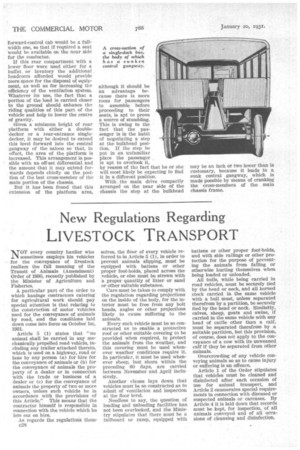New Regulations Regarding
Page 50

If you've noticed an error in this article please click here to report it so we can fix it.
LIVESTOCK TRANSPORT
NOT every country haulier who sometimes employs his vehicles
for the conveyance of livestock realizes the full meaning of the Transit of Animals (Amendment) Order of 1930, recently published by the Minister of Agriculture and Fisheries.
A particular part of the order to which haulage contractors catering for agricultural work should pay special attention is that relating to the construction of motor vehicles used for the conveyance of animals by road, and the conditions laid down come into force on October 1st, 1931.
Article 5 (1) states that " no animal shall be carried in any me
chanically propelled road vehicle, in cluding any trailer attached thereto, which is used on a highway, road or lane by any person (a) for hire for the conveyance of animals or (b) for the conveyance of animals the pro perty of a dealer or in connection with the trade or business of a dealer or (c) for the conveyance of animals the property of two or more owners, unless such vehicle be in accordance with the provisions of this Article." This means that the contractor himself is responsible in connection with the vehicle which he lets out on hire.
As regards the regulations themc28
selves, the floor of every vehicle referred to in Article 5 (1), in order to prevent animals slipping, must be equipped with battens or other proper foot-holds, placed across the vehicle, or else must be strewn with a proper quantity of litter or sand or other suitable substance.
Care must be taken to comply with the regulation regarding projections on the inside of the body, for the interior must be free from any bolt heads, angles or other projections likely to cause suffering to the animals.
Every such vehicle must be so constructed as to enable a protective roof or other suitable covering to he provided when required, to protect the animals from the weather, and this covering must be used whenever weather conditions require it. In particular, it must be used whenever sheep, last shorn within the preceding 60 days, are carried between November and April inclusively.
Another clause lays down that vehicles must be so constructed as to admit of ventilation and inspection at the floor level.
Needless to say, the question of loading and unloading facilities has. not been overlooked, and the Ministry stipulates that there must be a tailboard or ramp, equipped with battens or other proper foot-holds, and with side railings or other protection for the purpose of preventing the animals from falling or otherwise hurting themselves when being loaded or unloaded.
All bulls, while being carried in road vehicles, must be securely tied by the head or neck, and all horned stock carried in the same vehicle with a bull must, unless separated therefrom by a partition, be securely tied by the head or neck. Similatly, calves, sheep, goats and swine, if carried in the same vehicle with any head of cattle other than a calf, must be separated therefrom by ,a suitable partition, but this provision, of course, does not apply to the conveyance of a cow with its unweaned calf if they be separated from other animals.
Overcrowding of any vehicle conveying animals so as to cause injury or suffering is an offence.
Article 1 of the Order stipulates that vehicles must be cleaned and disinfected after each occasion of use for animal transport, and Article 2 enumerates special requirements in connection with diseased or suspected animals or carcases. By Article 4 it is laid down that records must be kept, for inspection, of all animals conveyed and of all occasions of cleansing and disinfection.












































































































